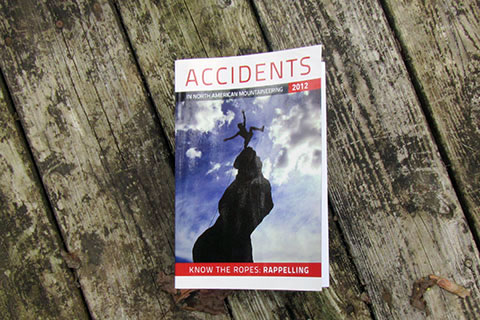| 702 | Accidents in North American Mountaineering, 2012 | 2012-09-12 |

In late summer of each year, the American Alpine Club publishes Accidents in North American Mountaineering. It is not an exciting read; but it is an important one.
In the volume, the editors describe some of the accidents that occurred in the preceding year (the 2012 book covers the accidents from 2011) and give analysis or insight to the causes of the incidents. Some of the accidents are self reported and others are documented by the land managers or their personnel.
The 2012 issue includes an educational topic. The purpose of the report is to increase knowledge and decrease accidents. This year's topic is an in depth look at rappelling. As noted below, there were 12 serious rappelling accidents last year.
We all make mistakes in our outdoor travels. Most mistakes occur, without serious consequences; but others are not as lucky. Those are the accidents that are reported in the book. It is important to read the book to gain awareness and knowledge from the lessons of others. Some of the accidents could happen to you and me! Read, learn, practice, and be careful.
A few stats ...
There were 12 rappelling errors. Most of them had to do with rope handling. Tie a knot in the end of the ropes!!!
At least 10 accidents were caused by rigging or belaying errors. Several accidents were caused by knots coming untied.
Poor or no communications was the chief cause of at least 8 accidents.
Climbing unroped was a contributory cause in 10 accidents.
There were 6 incidents where the climbers were scrambling over Class 3 or 4 terrain.
A few of the accidents ...
Climber fell on a top rope climb, but was not tied into the rope. p 24
An inexperienced climber had to be rescued (no injury) and then bragged about pushing the easy button - call for a rescue and they come. p 26
A falling flake severed the climbing rope. p 36
The rope cut off a falling climbers thumb (this happened last year also!) p 37
Belay rope knot came untied during a climb! p 51
A climber in Rocky Mountain National Park was rescued on Longs Peak after falling while soloing a snow climb. He was using retro gear. The same climber had to be rescued two weeks before from Mount Lady Washington! p 53
Several incidents of climbers needing assistance because they did not know the descent routes. pp 54 - 56 Note: It is as important to know how to get down as it is to get up. Often times we climb the descent route first, just to make sure we know how to get down!
A climber received a snake bite at the Great Falls National Park in VA. p 82
A top rope anchor failed. The knot on the webbing apparently came untied. The system had been used several times before the accident without any issues. p 83
While lowering from a bolt in a roof, the bolt pulled out and the climber fell to the ground. p 97
One climber was CUI, you know, solo climbing under the influence. p 99
A man with limited climbing experience tried to solo Grand Teton. p 108
Learn from the mistakes of others. Climb safely.
Happy safe climbing trails